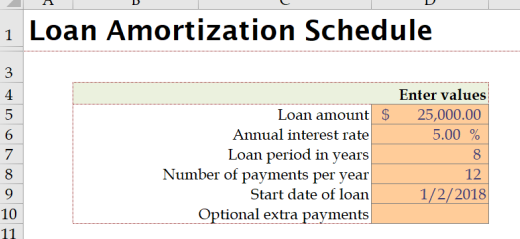Making Excel traceable and auditable
The parameters in this spreadsheet have been filled in with an eight year, $25,000 loan at 5% annual interest. But where did those numbers come from? Have they been changed? It's impossible to know from looking at the spreadsheet, so it's up to users to keep track of data and spreadsheet versions.
Let's say the bank data was copied from a scratch sheet the borrower had for comparing loans. The picture shows selecting the table in the scratch sheet and using the TrueOffice add-in's "Publish From Selection" function, turning the numbers into truenumbers with one click.
If we copy them from the scratch sheet into the amortization spreadsheet now as truenumbers, the metadata encrypted inside provides positive, immutable identification we can see by hovering the cell.
Automatic archiving of sources
Selecting that truenumber lights up the "View Source" icon in the Truenumber Toolbar. When the truenumbers were published from the borrower's scratch sheet, that spreadsheet was automatically archived in the truenumber cloud. Clicking the View Source button by an authorized user would download it, so we have full provenance leading to the source of the interest rate attached to the truenumber wherever it goes.
Effortless governance and resource building
So far, we've seen how easily users can create shared, manageable data, and archive documents in the cloud, eliminating uncertainties that have always plagued spreadsheets. But what happens if a user makes "what if" changes to a parameter? Without the TrueOffice add-in, the number reverts to being an ordinary number, so at least we know that there is no longer any governance for it. But if TrueOffice is installed, it will automatically create a new truenumber when the user tries to change one, and tags it in the cloud as a variant of the original. Since every new truenumber is ID'd, time-stamped and marked with the credentials of its author, an audit trail for changes in spreadsheet data is automatically maintained. More important is that one click on a truenumber in Excel can tell us whether we are looking at an original truenumber or a variant, and point us to the original if we want to find it.
searching on a truenumber's variant tag retrieves all versions of the original. the selected number was created 9 days after the original was created.
Using Truenumbers and MS-Office means user-created solutions can rival custom database applications while retaining the agility and control desktop tools offer.






